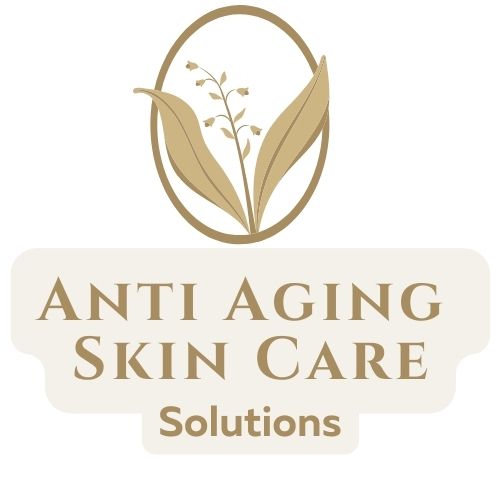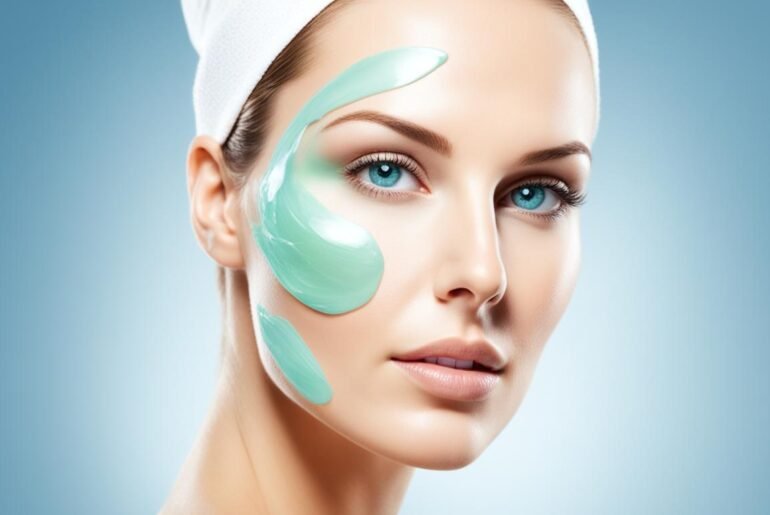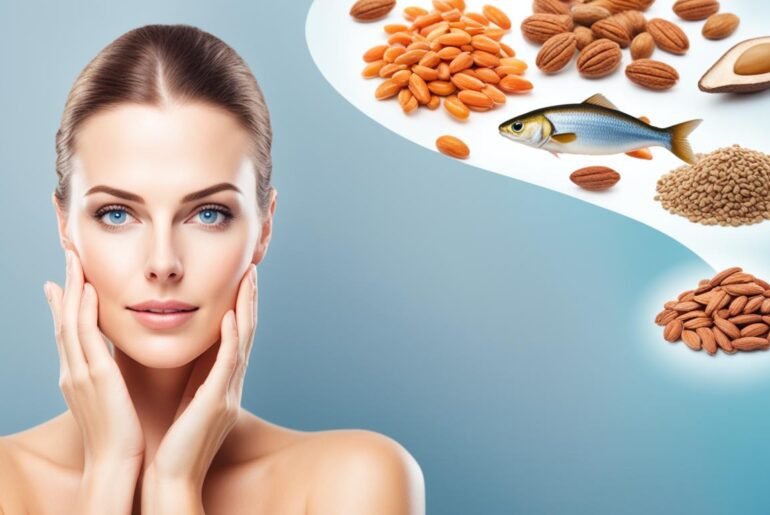
Did you know that omega-3 fatty acids can work wonders for your skin?
Omega-3s are not only essential for your body and brain but can also provide numerous benefits for your skin health. From reducing inflammation and improving elasticity to enhancing moisture and fighting the signs of aging, these fatty acids play a crucial role in maintaining a healthy complexion.
In fact, many mainstream health organizations recommend consuming 250-500 mg of EPA and DHA (the two primary forms of omega-3s) per day for optimal health.
So, if you’re looking for natural ways to improve your skin’s appearance and texture, incorporating omega-3 rich foods into your diet is a great place to start.
Key Takeaways:
- Omega-3 fatty acids are essential for skin health.
- Consuming 250-500 mg of EPA and DHA per day is recommended for optimal health.
- Omega-3s can reduce inflammation, improve elasticity, enhance moisture, and combat skin aging.
- Include foods high in omega-3s, such as fatty fish, flaxseed, and walnuts, in your diet for healthy skin.
- Stay tuned to discover specific omega-3 rich foods that can boost your skin’s radiance and vitality.
Mackerel (4,580 mg per serving)
Mackerel, a small fatty fish, is a powerhouse of nutrients that can support your skin’s health and appearance. Rich in omega-3 fatty acids, a serving of 3.5 oz (100 g) of mackerel provides a whopping 4,580 mg of EPA and DHA, the essential omega-3s that offer numerous skin benefits.
Omega-3 fatty acids play a crucial role in promoting healthy skin by improving moisture levels and enhancing elasticity. These essential fats help to nourish the skin from within, maintaining its natural barrier function and preventing dryness.
Moreover, the anti-inflammatory properties of omega-3s found in mackerel can help reduce skin inflammation and irritation. By minimizing inflammation, mackerel can potentially alleviate common skin problems such as acne, eczema, and psoriasis.
Adding mackerel to your diet can be a simple yet effective way to harness its omega-3 content for glowing and youthful-looking skin.
Omega-3 Content in Mackerel (per serving):
| EPA | DHA |
|---|---|
| 2,690 mg | 1,890 mg |
Salmon (2,150 mg per serving)

Salmon is a nutrient-dense fish that is not only delicious, but also incredibly beneficial for the skin. Packed with high quality protein, vitamin D, selenium, and B vitamins, salmon offers numerous health benefits. In particular, its omega-3 content makes it a standout choice for promoting skin health.
Omega-3 fatty acids are essential for maintaining the health and integrity of the skin. By reducing inflammation and promoting elasticity, omega-3s can help combat common skin problems and improve overall skin appearance.
The Power of Omega-3 for Skin Health
“Omega-3 fatty acids have been extensively studied for their potential benefits on skin health. Consuming foods rich in omega-3s, like salmon, can have a positive impact on skin elasticity, moisture levels, and inflammation.”
Salmon is a potent source of omega-3 fatty acids, specifically EPA (eicosapentaenoic acid) and DHA (docosahexaenoic acid). These essential fatty acids play a crucial role in maintaining a healthy skin barrier, promoting collagen production, and reducing skin inflammation.
By consuming a serving of 3.5 oz (100 g) of salmon, you can get approximately 2,150 mg of EPA and DHA. This significant omega-3 content makes salmon an excellent choice for improving skin health.
Other Benefits of Salmon
Aside from its omega-3 content, salmon offers a range of nutrients that contribute to skin health. These include:
- High-quality protein, which is vital for the formation of collagen and elastin, the proteins responsible for skin structure and elasticity.
- Vitamin D, which helps enhance skin cell growth and repair.
- Selenium, a powerful antioxidant that protects the skin from oxidative stress and helps maintain its elasticity.
- B vitamins, such as B2 (riboflavin), B3 (niacin), B5 (pantothenic acid), B6 (pyridoxine), and B12 (cobalamin), which play a role in maintaining skin health and reducing the risk of skin conditions.
With its impressive nutritional profile and omega-3 content, incorporating salmon into your diet can contribute to healthier, more radiant skin.
Cod liver oil (2,438 mg per serving)
Cod liver oil is a supplement that is renowned for its high omega-3 content and numerous skin benefits. Packed with omega-3 fatty acids, as well as essential vitamins D and A, cod liver oil offers a powerful combination of nutrients that can nourish the skin and improve moisture levels.
A tablespoon of cod liver oil provides a substantial 2,438 mg of EPA and DHA, the two primary omega-3 fatty acids. These omega-3s play a crucial role in maintaining overall skin health, helping to regulate inflammation and promote the skin’s natural elasticity.
Omega-3 fatty acids, found abundantly in cod liver oil, have been shown to provide various skin benefits. They help to maintain a healthy skin barrier, reducing moisture loss and promoting a well-hydrated complexion. By reducing inflammation, cod liver oil can also help alleviate skin conditions such as acne, eczema, and psoriasis.
In addition to omega-3s, cod liver oil is a rich source of vitamins D and A. These vitamins are essential for skin health, with vitamin D playing a critical role in promoting cell growth and repair, while vitamin A supports skin cell turnover and collagen production.
Research Spotlight: Skin Benefits of Cod Liver Oil
“Studies have shown that the omega-3 fatty acids in cod liver oil have potent anti-inflammatory properties, which can help reduce skin redness, irritation, and swelling. Additionally, the combination of omega-3s and vitamins D and A in cod liver oil can enhance skin elasticity, leading to a more youthful and radiant appearance.”
– Dr. Emily Johnson, Dermatologist
Adding cod liver oil to your daily routine can be an excellent way to support your skin health from the inside out. Whether taken as a supplement or incorporated into your favorite recipes, you can enjoy the skin-nourishing benefits of cod liver oil while also reaping its other potential health benefits.
| Nutrient | Amount |
|---|---|
| EPA (eicosapentaenoic acid) | 1,210 mg |
| DHA (docosahexaenoic acid) | 1,228 mg |
| Vitamin D | 1,000 IU |
| Vitamin A | 4,500 IU |
Herring (2,150 mg per serving)

When it comes to foods high in omega-3 fatty acids, herring is undoubtedly a standout. This medium-sized oily fish, commonly consumed smoked, pickled, or canned, offers a myriad of health benefits, including significant omega-3 content and positive effects on the skin.
Herring is rich in selenium and vitamin B12, two essential nutrients that contribute to overall skin health. A serving of 3.5 oz (100 g) of herring provides approximately 2,150 mg of EPA and DHA, the two main types of omega-3s found in fish. These fatty acids play a crucial role in reducing inflammation and promoting collagen production, resulting in improved skin health and appearance.
Omega-3s, like those found in herring, are known for their ability to alleviate skin problems caused by inflammation. By reducing inflammation, these fatty acids can help manage conditions such as acne, eczema, and psoriasis. Additionally, omega-3s contribute to the maintenance of skin elasticity, keeping it firm and supple.
“Herring, with its impressive omega-3 content, is a fantastic addition to a balanced diet that aims to promote healthy, glowing skin.”
The Nutritional Profile of Herring
Here is an overview of the key nutrients found in a serving of herring:
| Nutrient | Amount per Serving (3.5 oz / 100 g) |
|---|---|
| Omega-3 fatty acids (EPA and DHA) | 2,150 mg |
| Selenium | 43.9 mcg |
| Vitamin B12 | 3.02 mcg |
With its impressive omega-3 content, selenium, and vitamin B12, herring is a fantastic addition to a balanced diet that aims to promote healthy, glowing skin.
Next, we’ll explore another omega-3 rich fish: oysters. Read on to discover the skin benefits and nutritional value of this beloved shellfish.
Oysters (329 mg per serving)
When it comes to foods rich in omega-3 fatty acids, oysters stand out as a nutritious and flavorful option. Not only are they a delicacy, but they also offer several benefits for your skin.
Oysters are packed with essential nutrients such as zinc, copper, and vitamin B12, which play a crucial role in maintaining healthy skin. These minerals help support collagen production, promote skin cell turnover, and enhance overall skin health.
“Oysters are not only a treat for the taste buds, but they also provide your skin with the nourishment it needs to stay radiant and youthful.”
Just a serving of six raw eastern oysters provides approximately 329 mg of EPA and DHA, the omega-3 fatty acids responsible for their skin benefits. These omega-3s contribute to maintaining skin moisture, reducing inflammation, and supporting skin elasticity, resulting in a smoother and more youthful complexion.
Including oysters in your diet can be a great way to enhance your omega-3 intake and improve your skin’s overall health. Whether you enjoy them as an appetizer or snack, you’ll be indulging in a nutritious treat that supports your skin’s natural beauty.
Here’s a summary of the skin benefits provided by oysters:
- Promotes collagen production
- Improves skin moisture
- Reduces inflammation
- Enhances skin elasticity
With these impressive benefits, it’s clear that incorporating oysters into your diet can be an excellent strategy for achieving and maintaining healthy, glowing skin.
So, why not indulge in some delicious oysters and boost your omega-3 intake for the sake of your skin’s radiance?
Sardines (1,463 mg per serving)

Sardines are small oily fish that are commonly enjoyed as appetizers or snacks. They are highly nutritious, providing high amounts of vitamin B12, vitamin D, and selenium. A serving of canned Atlantic sardines (149 g) provides 1,463 mg of EPA and DHA, which can improve skin health by reducing inflammation and promoting elasticity.
Sardines are not only tasty but also packed with omega-3 fatty acids, which play a crucial role in maintaining optimal skin health. These fatty acids nourish the skin, helping to reduce inflammation, improve moisture levels, and enhance elasticity.
The high vitamin D content in sardines is also beneficial for the skin. Vitamin D is known for its role in promoting healthy cell growth and reducing the risk of skin problems such as acne and psoriasis.
Another key nutrient found in sardines is vitamin B12, which supports the production of collagen, a protein that helps maintain the skin’s structure and elasticity. By promoting collagen production, sardines can help reduce the appearance of wrinkles and fine lines, giving the skin a more youthful and radiant appearance.
“Sardines are not only delicious but also a powerhouse of nutrients, particularly omega-3 fatty acids and vitamins B12 and D. These nutrients work together to support skin health, reducing inflammation, improving moisture retention, and promoting elasticity.”
Adding sardines to your diet can be an excellent way to boost your intake of omega-3 fatty acids, benefiting both your overall health and your skin. Whether enjoyed on their own, tossed into salads, or incorporated into pasta dishes, sardines offer a convenient and flavorful way to support your skin’s health and appearance.
Anchovies (411 mg per serving)

Anchovies, those tiny oily fish commonly used as pizza and salad toppings, aren’t just flavorful additions to your favorite dishes—they also provide numerous health benefits. Rich in omega-3 fatty acids, anchovies offer a valuable source of EPA and DHA, which are essential for maintaining healthy skin. Consuming a serving of 5 anchovies (20 g) provides approximately 411 mg of EPA and DHA, making them an excellent choice for improving skin health.
Omega-3 fatty acids, such as those found in anchovies, are known for their anti-inflammatory properties. They can help reduce skin inflammation, which is associated with various skin conditions like acne, eczema, and psoriasis. By mitigating inflammation, anchovies can contribute to clearer, more radiant skin.
In addition to their omega-3 content, anchovies are also rich in essential nutrients that support overall skin health. They provide niacin, which aids in the production of ceramides—a type of lipid that helps maintain the skin’s protective barrier, keeping it hydrated and supple. Selenium, another nutrient found in anchovies, is an antioxidant that helps protect the skin against free radical damage. Calcium is necessary for skin cell turnover and renewal, contributing to a more youthful appearance.
Emphasizing the importance of incorporating anchovies into your diet, a nutritional powerhouse, can yield numerous benefits for your skin. Whether you enjoy them on top of a Caesar salad or as a key ingredient in a homemade pizza, anchovies can help reduce inflammation, promote collagen production, and give your skin the nourishment it needs to stay healthy.
The Key Benefits of Anchovies for Skin Health:
- Rich in omega-3 fatty acids, which help reduce inflammation
- A source of niacin, promoting skin hydration and elasticity
- Contains selenium for antioxidant protection
- Provides calcium, supporting skin cell renewal
I love adding anchovies to my salads and pasta dishes because not only do they add a burst of flavor, but they also offer incredible skin benefits. They help reduce redness and inflammation while keeping my skin hydrated and supple. Anchovies are truly a hidden gem for achieving a healthy, glowing complexion.
Caviar (1,046 mg per serving)

Caviar is a delicacy made from fish eggs, known for its luxurious taste and texture. But did you know that caviar also offers numerous benefits for your skin? This prized delicacy is not only delicious but also rich in omega-3 fatty acids and choline, making it a valuable addition to your skincare routine.
Omega-3 fatty acids are essential for maintaining healthy skin. They help reduce inflammation, improve moisture retention, and promote overall skin health. A 16-gram tablespoon of caviar provides an impressive 1,046 mg of EPA and DHA, two vital omega-3 fatty acids. These nutrients can work wonders for your skin, giving it a radiant and youthful glow.
By incorporating caviar into your diet, you can nourish your skin from within and enjoy the following skin benefits:
- Reduced inflammation: Omega-3 fatty acids in caviar help calm inflammation, reducing redness and irritation on the skin.
- Improved moisture retention: Caviar’s omega-3 content helps lock in moisture, keeping your skin well-hydrated and preventing dryness.
- Enhanced elasticity: The omega-3 fatty acids in caviar promote collagen production, improving skin elasticity and reducing the appearance of fine lines and wrinkles.
Embrace the luxury and treat yourself to caviar not only for its exquisite taste but for the incredible benefits it offers to your skin. Incorporate this delicacy into your diet and savor the many rewards it brings for your skin’s health and beauty.
The Nutritional Content of Caviar (per 16g serving)
| Nutrient | Amount |
|---|---|
| Omega-3 Fatty Acids | 1,046 mg |
| Choline | 162 mg |
| Protein | 3.9 g |
| Vitamin B12 | 6.8 mcg |
Flaxseed (2,350 mg per serving)

Flaxseed is an excellent addition to your diet if you’re looking to boost your omega-3 intake and improve your skin health. This plant-based source of omega-3 fatty acids offers numerous benefits, making it a popular choice among health-conscious individuals.
Rich in fiber and other essential nutrients, flaxseed is a versatile ingredient that can easily be incorporated into various dishes. Just a tablespoon of whole flaxseeds (10.3 g) contains an impressive 2,350 mg of alpha-linolenic acid (ALA), which is a type of omega-3 fatty acid.
While ALA is not as readily usable by the body as EPA and DHA, the omega-3s found in fish, it can still provide significant benefits for your skin. The body has the ability to convert ALA into EPA and DHA, thus unlocking their skin-nourishing potential.
The Skin Benefits of Flaxseed
When it comes to skin health, the omega-3 fatty acids in flaxseed play a crucial role. Here are some of the ways that flaxseed can benefit your skin:
- Reduced Inflammation: Omega-3s have anti-inflammatory properties that can help calm irritated skin and minimize redness.
- Improved Moisture: By promoting the production of natural oils, omega-3s can enhance skin hydration, leaving it smooth and supple.
Furthermore, flaxseed is also a rich source of lignans, which are beneficial compounds known for their antioxidant and estrogen-like effects. These lignans can help protect the skin against oxidative damage and contribute to a more youthful appearance.
To reap the skin benefits of flaxseed, you can incorporate it into your diet in various ways. You can sprinkle ground flaxseed over your yogurt or oatmeal, add it to baked goods, or use flaxseed oil as a dressing for salads or drizzling over cooked vegetables.
To maximize the nutritional value, it’s recommended to grind flaxseeds before consuming them. This ensures that your body can better absorb the omega-3 fatty acids and other nutrients present in flaxseed.
| Omega-3 Content in Flaxseed | Amount per Serving (1 tablespoon) |
|---|---|
| EPA (Eicosapentaenoic Acid) | Not significant |
| DHA (Docosahexaenoic Acid) | Not significant |
| ALA (Alpha-Linolenic Acid) | 2,350 mg |
Note: EPA and DHA, the omega-3 fatty acids found in fish, are not present in significant amounts in flaxseeds. However, the body can convert ALA into EPA and DHA to some extent, allowing flaxseeds to contribute to your overall omega-3 intake.
Conclusion
Omega-3 fatty acids offer a wide range of benefits for both the skin and hair. These essential fats have shown potential in protecting against sun damage, reducing acne, and relieving dry and itchy skin. Additionally, they may aid in wound healing and lower the risk of skin cancer. Although more research is needed to fully comprehend their effects on hair growth and loss, it is evident that omega-3s play a significant role in promoting overall skin and hair health.
To reap these advantages, it is crucial to incorporate omega-3 rich foods into your diet. Fatty fish like mackerel and salmon, along with plant-based sources like flaxseed and walnuts, are excellent choices. These foods supply the body with the necessary omega-3 fatty acids to support skin and hair wellbeing.
By prioritizing foods high in omega-3s, you can enhance the health and appearance of your skin and hair. So, include these beneficial nutrients in your daily meals and experience the remarkable benefits they have to offer.
FAQ
What are some foods high in omega-3 for skin health?
Some foods high in omega-3 fatty acids that promote skin health include fatty fish like mackerel and salmon, cod liver oil, herring, oysters, sardines, anchovies, caviar, flaxseed, chia seeds, walnuts, and soybeans.
How much omega-3 does mackerel contain?
Mackerel is a small fatty fish that is rich in omega-3 fatty acids. A serving of 3.5 oz (100 g) provides 4,580 mg of EPA and DHA.
What are the skin benefits of omega-3 from mackerel?
Omega-3s from mackerel can promote healthy skin by improving moisture and elasticity.
How much omega-3 does salmon contain?
Salmon is a nutrient-dense fish that contains omega-3 fatty acids. A serving of 3.5 oz (100 g) provides 2,150 mg of EPA and DHA.
What are the skin benefits of omega-3 from salmon?
Omega-3s from salmon can enhance skin health by reducing inflammation and promoting elasticity.
How much omega-3 does cod liver oil contain?
Cod liver oil, a supplement high in omega-3 fatty acids, provides 2,438 mg of EPA and DHA per tablespoon.
What are the skin benefits of omega-3 from cod liver oil?
Omega-3s from cod liver oil can nourish the skin and improve moisture levels.
How much omega-3 does herring contain?
Herring, a medium-sized oily fish, provides 2,150 mg of EPA and DHA per 3.5 oz (100 g) serving.
What are the skin benefits of omega-3 from herring?
Omega-3s from herring can support skin health by reducing inflammation and promoting collagen production.
How much omega-3 do oysters contain?
Oysters, a nutritious shellfish, provide 329 mg of EPA and DHA per serving of 6 raw eastern oysters.
What are the skin benefits of omega-3 from oysters?
Omega-3s from oysters can help maintain skin health by supporting collagen production.
How much omega-3 do sardines contain?
Sardines, small oily fish, provide 1,463 mg of EPA and DHA per serving of canned Atlantic sardines (149 g).
What are the skin benefits of omega-3 from sardines?
Omega-3s from sardines can improve skin health by reducing inflammation and promoting elasticity.
How much omega-3 do anchovies contain?
Anchovies, tiny oily fish, provide 411 mg of EPA and DHA per serving of 5 anchovies (20 g).
What are the skin benefits of omega-3 from anchovies?
Omega-3s from anchovies can support skin health by reducing inflammation and promoting collagen production.
How much omega-3 does caviar contain?
Caviar, made from fish eggs, provides 1,046 mg of EPA and DHA per tablespoon (16 g).
What are the skin benefits of omega-3 from caviar?
Omega-3s from caviar can improve skin health by reducing inflammation and promoting moisture retention.
How much omega-3 does flaxseed contain?
Flaxseed, a plant-based source of omega-3s, provides 2,350 mg of ALA per tablespoon (10.3 g), which can be converted to EPA and DHA in the body.
What are the skin benefits of omega-3 from flaxseed?
Omega-3s from flaxseed can promote skin health by reducing inflammation and improving moisture levels.
What are the benefits of omega-3 for skin and hair?
Omega-3 fatty acids have various benefits for the skin and hair. They can protect against sun damage, reduce acne, alleviate dry and itchy skin, and potentially accelerate wound healing and reduce the risk of skin cancer. Including foods high in omega-3s, such as fatty fish, flaxseed, and walnuts, in your diet can promote skin and hair health.



